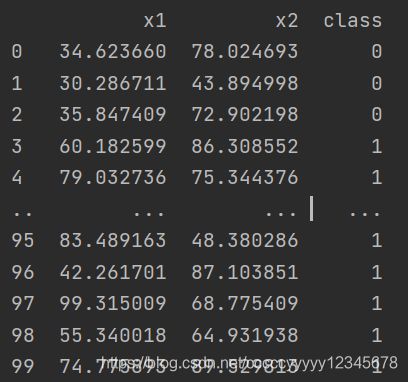机器学习笔记4:Python底层实现线性回归
历史文章:
1、python底层实现KNN:https://blog.csdn.net/cccccyyyyy12345678/article/details/117911220
2、Python底层实现决策树:https://blog.csdn.net/cccccyyyyy12345678/article/details/118389088
3、Python底层实现贝叶斯:https://blog.csdn.net/cccccyyyyy12345678/article/details/118411638
前言
实现线性回归的方法包括梯度下降法和正规方程,本文只介绍梯度下降法。
本文实现了普通梯度下降多元线性回归和带L2正则化的梯度下降多元线性回归。正则化可以降低高次项的权重系数,从而防止过拟合。
1、导入数据
数据如下:
导入数据使用pandas库,代码如下:
def read_xlsx(path):
data = pd.read_excel(path)
print(data)
return data2、归一化
归一化方法与KNN中用到的方法相同,这里用归一化消除量纲的目的是使得梯度下降的速度更快。
def MinMaxScaler(data):
col = data.shape[1]
for i in range(0, col-1):
arr = data.iloc[:, i]
arr = np.array(arr)
min = np.min(arr)
max = np.max(arr)
arr = (arr-min)/(max-min)
data.iloc[:, i] = arr
return data3、划分训练集和测试集
def train_test_split(data, test_size=0.2, random_state=None):
col = data.shape[1]
x = data.iloc[:, 0:col-1]
y = data.iloc[:, -1]
x = np.array(x)
y = np.array(y)
# 设置随机种子,当随机种子非空时,将锁定随机数
if random_state:
np.random.seed(random_state)
# 将样本集的索引值进行随机打乱
# permutation随机生成0-len(data)随机序列
shuffle_indexs = np.random.permutation(len(x))
# 提取位于样本集中20%的那个索引值
test_size = int(len(x) * test_size)
# 将随机打乱的20%的索引值赋值给测试索引
test_indexs = shuffle_indexs[:test_size]
# 将随机打乱的80%的索引值赋值给训练索引
train_indexs = shuffle_indexs[test_size:]
# 根据索引提取训练集和测试集
x_train = x[train_indexs]
y_train = y[train_indexs]
x_test = x[test_indexs]
y_test = y[test_indexs]
# 将切分好的数据集返回出去
# print(y_train)
return x_train, x_test, y_train, y_test4、梯度下降线性回归
(1)普通梯度下降
梯度下降法是迭代法的一种,可以用与求解最小二乘问题。直接用最小二乘法计算得到的过程即正规方程。而梯度下降则是一步一步逼近最优解(也可能是局部最优解)。
损失函数用真实值和预测值的均方误差来定义
def costFunction(x, y, theta):
m = len(x)
J = np.sum(np.power(np.dot(x, theta) - y, 2)) / (2 * m)
return J固定步长和迭代次数进行梯度下降:
def gradeDesc(x,y,alpha=0.01,iter_num=2000):
x = np.array(x)
y = np.array(y).reshape(-1, 1)
m = x.shape[0]
n = x.shape[1]
theta = np.zeros(n + 1).reshape(-1, 1)
c = np.ones(m).transpose() #构建m行1列 x0=1
x = np.insert(x, 0, values=c, axis=1)
costs = np.zeros(iter_num) # 初始化cost, np.zero生成1行iter_num列都是0的矩阵
for i in range(iter_num):
for j in range(n):
theta[j] = theta[j] + np.sum((y - np.dot(x, theta)) * x[:, j].reshape(-1, 1)) * alpha / m
costs[i] = costFunction(x, y, theta)
return theta, costs(2)带L2正则化梯度下降
L2正则化需要最小化权值,因此引入惩罚项来控制权值。
def l2costFunction(x, y, lamda, theta):
m = len(x)
J = np.sum(np.power((np.dot(x, theta) - y), 2)) / (2 * m) + lamda * np.sum(np.power(theta, 2))
return J梯度下降过程中唯一的不同就是求导后的公式
def l2gradeDesc(x, y, alpha, iter_num, lamda):
x = np.array(x)
y = np.array(y).reshape(-1, 1)
m = x.shape[0]
n = x.shape[1]
theta = np.zeros(n + 1).reshape(-1, 1)
c = np.ones(m).transpose()
x = np.insert(x, 0, values=c, axis=1)
costs = np.ones(iter_num)
for i in range(iter_num):
for j in range(n):
theta[j] = theta[j] + np.sum((y - np.dot(x, theta)) * x[:, j].reshape(-1, 1)) * (alpha / m) - 2 * lamda * theta[j]
costs[i] = l2costFunction(x, y, lamda, theta)
return theta, costs
5、预测y值
def predict(x, theta):
x = np.array(x)
c = np.ones(x.shape[0]).transpose()
x = np.insert(x, 0, values=c, axis=1)
y = np.dot(x, theta)
return y6、模型评估
评估线性模回归模型的指标为均方误差(MSE)。
def mse(y_true, y_test):
mse = np.sum(np.power(y_true - y_test, 2)) / len(y_true)
return mse7、画图
随着迭代次数的增加,误差下降。
#画图cost曲线
ax1 = plt.subplot(121)
iter_num = 2000
x_ = np.linspace(1, iter_num, iter_num)
ax1.plot(x_, costs)
plt.show()总结
梯度下降法线性回归是逻辑回归等算法的基础。
完整代码上传GitHub:https://github.com/chenyi369/Regression
